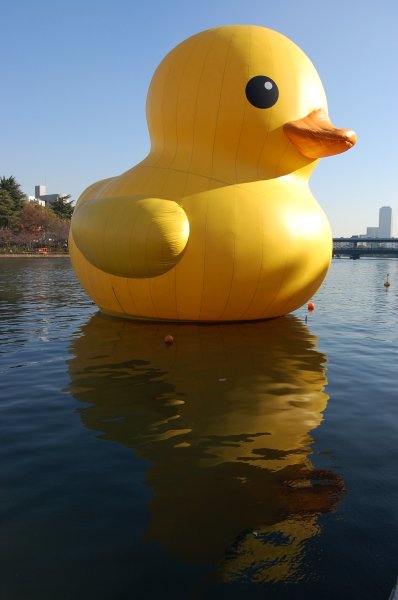FLORENTIJN HOFMAN
Humour, sensation, maximum impact; internationally renowned Dutch artist Florentijn Hofman (Delfzijl, 1977) does not settle for less. His sculptures are large, very large, and are bound to make an impression. Take Rubber Duck (2007) for example: a gigantic 26-metre-high yellow rubber duck. It is an inflatable, based on the standard model that children from all four corners of the world are familiar with. The impressive rubber duck travels the world and pops up in many different cities: from Auckland and São Paulo to Osaka. A very positive artistic statement that immediately connects people to their childhood.
Hachikenya-hama Osaka-City,Japan
Another example is Fat Monkey (São Paulo, Brazil 2010), a huge monkey tied together from 10,000 brightly coloured flipflops, the Brazilian shoe par excellence.
The monkey is lying stretched out in the park, where his 15-metre length makes passers-by stop dead in their tracks.
Hofman’s sculptures often originate from everyday objects. A straightforward paper boat, a pictogram of an industrial zone or mass-produced little toy figures can all serve as sources. They are all ready-mades, selected by Hofman for the beauty of their forms.
Subsequently he crafts these into clear and iconic images; cartoonish blow-ups of reality that alienate and unsettle through their sheer size and use of materials. Nevertheless they are immediately identifiable and have an instant appeal. Inflatables, window stickers, agricultural plastic sheeting: for Hofman any material is suitable for turning into art.
The skin of Big Yellow Rabbit (Örebro, Sweden 2011) for example consisted of thousands of Swedish shingles.
A wooden frame was covered in reed for Muskrat - Holland, (2004).
Look-out Rabbit (2011)
The Lookout Rabbit is a temporary 12 meter high sculpture. It's a rabbit with a red dot which you can enter and have a look out over the river the Waal. The work is situated at the Valkhofpark at Nijmegen..
Hofman’s projects are often very labour-intensive. Gravity is being defied though by his love of materials and craft.
Next to temporary and permanent sculptures in the public domain Hofman has realised several other projects. In Beukelsblauw (2004-2006) he brought attention to a block of houses, destined for demolition, by painting the buildings bright blue from top to bottom.
For Zirkus Zeppelin (2008), on the occasion of the opening of motorway N470, Hofman chose 470 people to fly with him on the world’s largest zeppelin and view their everyday surroundings from the air. In these specific projects Hofman invites spectators to reconsider things that at first appear to be a matter of course.
Although artists do not always tend to value reactions of passers-by, for Hofman the audience is an essential part of his work. He takes due care of embedding his images in their surroundings. For Steelman (2011) he therefore engaged in conversation with young local residents of the Staalmanplein (Staalmansquare), a formerly rough neighbourhood in Amsterdam Slotervaart.
Subsequently he conceived of an 11-metre high bear with a pillow under its arm. Hofman: ‘The bear is tough and is standing straddle-legged. Those who live in this neighbourhood have to stand their ground. At the same time the bear is a symbol of fraternization. People socialise at the foot of the sculpture.’
An encounter with one of Hofman’s extraordinary sculptures invites us to stand still for a moment and to look; to really look and to take a picture if you like. Hofman: ‘My sculptures cause an uproar, astonishment and put a smile on your face. They give people a break from their daily routines. Passers-by stop in front of them, get off their bicycle and enter into conversation with other spectators. People are making contact with each other again. That is the effect of my sculptures in the public domain.’
Via | Via | Via






















.jpg)










.JPG)
.JPG)
.JPG)
.JPG)
.JPG)

.JPG)
.JPG)








No comments:
Post a Comment